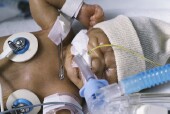- Skip Storing This Everyday Product in the Fridge Door
- Green Tea + B3 Pairing May Boost Brain Health
- Navigating Your Midlife Crisis: Embracing New Possibilities
- City Raccoons Showing Signs of Domestication
- Mapping the Exposome: Science Broadens Focus to Environmental Disease Triggers
- One Week Less on Social Media Linked to Better Mental Health
- Your Brain Changes in Stages as You Age, Study Finds
- Some Suicide Victims Show No Typical Warning Signs, Study Finds
- ByHeart Formula Faces Lawsuits After Babies Sickened With Botulism
- Switch to Vegan Diet Could Cut Your Greenhouse Gas Emissions in Half
Simple Method May Help Predict Tiny Preemies’ Outlook


FRIDAY, Sept. 27Doctors may be able to look at a few simple factors to better predict how very premature babies will fare in the short term, a new study suggests.
When it comes to infants born extremely early, doctors traditionally focused on estimating the newborn’s odds of survival.
But these days, more and more tiny preemies are surviving, said Dr. Prakeshkumar Shah, a neonatologist at Mount Sinai Hospital in Toronto, and the senior researcher on the new study.
Now, he said, the task is to try to predict their chances of serious complications, such as heavy bleeding in the brain or severe breathing problems.
For the study, Shah’s team reviewed records for 6,100 infants born between the 23rd and 30th week of pregnancy. A full-term pregnancy typically lasts about 40 weeks, and any birth before the 37th week is considered preterm.
Shah’s team found that a collection of basic factors predicted whether very premature newborns would have mild or severe complications while still in the hospital.
Not surprisingly, Shah said, one of those factors was gestational age — or how far along the pregnancy was when the baby was born. Others factors included sex (boys fared worse), birth weight and whether moms had taken prenatal corticosteroids.
When a woman is at risk of preterm delivery, doctors may give her corticosteroids to speed the baby’s lung development. In this study, newborns whose moms did not receive the drugs had a higher risk of serious problems soon after birth.
All of the babies studied were treated at Canadian neonatal intensive-care units between 2010 and 2011. Overall, 10 percent died, while 37 percent survived with none of the short-term complications the study assessed — including bleeding in the brain, lung disease and infections of the blood or intestines.
Another 32 percent of the babies developed mild cases of those complications, while 20 percent had severe cases.
The distinction is important, Shah said. A small amount of bleeding in the brain, for example, usually causes no long-term consequences, while heavy bleeding can injure the brain and cause developmental delays.
The researchers found that when they considered a handful of factors, they were able to predict which group an infant would fall into 90 percent of the time.
Shah said the factors were all ones that doctors would already know when a baby is admitted to the ICU: gestational age, birth weight, sex, whether the mom took prenatal corticosteroids, whether the baby was born in or out of the hospital, and the condition of the baby’s lungs.
The findings, published online Sept. 23 in the journal Pediatrics, could help doctors prepare parents for what might happen in the short term, Shah said.
“This could open up avenues for discussions with parents about what is possible,” he said.
An expert not involved in the work agreed that the results could prove useful. “We’re trying to develop better and better tools to help us guide families through this process,” said Dr. Deborah Campbell, director of neonatology at the Children’s Hospital at Montefiore, in New York City.
A “prediction model” like this, Campbell said, could give doctors and families more information to discuss.
Other studies have come up with similar prediction models for estimating preemies’ odds of survival. But this one seems to gauge babies’ likelihood of a whole range of short-term outcomes, Shah said.
Campbell said this study’s model was one of the more complete ones she has seen, and could prove helpful. “We want to be able to give parents as much information as we have, in a meaningful way,” she said.
But “meaningful,” Campbell added, involves more than giving parents statistical probabilities. She also stressed that no prediction model can foretell what will happen to your baby specifically.
“We can use this information to help give parents a sense of where their child may fall as far as these outcomes,” she said. “But every baby is an individual.”
More information
The Mayo Clinic has more on preterm birth.
Source: HealthDay
Copyright © 2025 HealthDay. All rights reserved.










